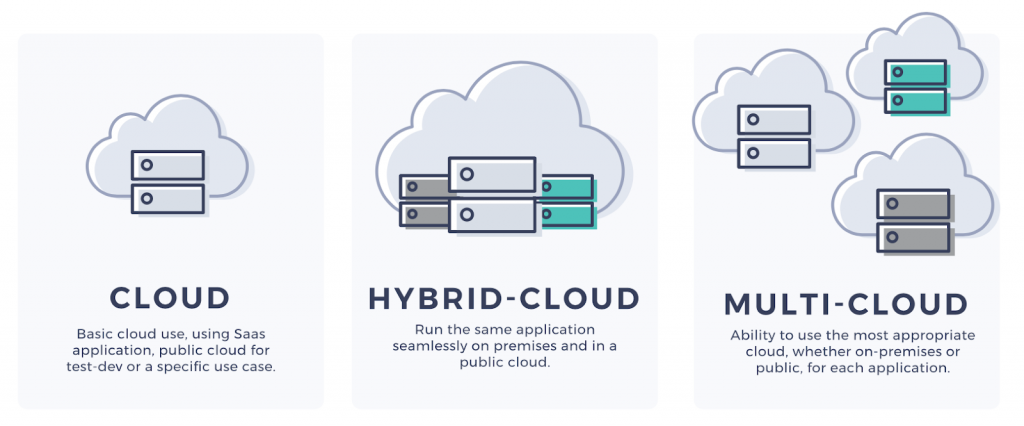Conversations around the cloud have shifted from “if” cloud adoption is necessary to “when” and “how” to do cloud migration in the right manner.
Cloud computing services have been growing at a staggering rate and are poised to touch USD 27.8 billion market size by 2026. However, excessive reliance on the cloud, especially public cloud services, do put enterprises at risk of being held hostage to their cloud vendor.
A study recently published by Morning Consult shows that 86% of IT decision-makers say that vendor lock-in by a cloud provider is a key concern in their purchasing decision.
Vendor lock-in not only refers to the incapacity of shifting to another cloud provider. It also includes the several assumptions and measures that the enterprise takes while building applications and workflows that are reliant on the public cloud’s inner workings. Excessive reliance on a public cloud provider can put enterprises in a tight spot where they may remain dependent on the public cloud vendor, and unable to make changes necessary for organizational growth.
As businesses work on getting their cloud strategy correct, a new ingredient is added to the mix — a multi-cloud strategy. Multi-cloud holds the key to unlocking the vendor lock-in risk that a public cloud strategy poses.
Let’s take a closer look at what multi-cloud is, how it works, and the differences compared to public, private, and hybrid clouds. We will cover in detail the several aspects to be considered and steps to be taken to implement a successful multi-cloud strategy.
Definition of multi-cloud
A multi-cloud environment is one where an organization uses a combination of public and private clouds for business needs. Applications and services could be distributed across the cloud environments depending on the specific strengths and capabilities of each cloud service provider.

Source: https://www.xorlogics.com/2019/11/25/pros-of-a-multi-cloud-strategy/
How is multi-cloud different from public cloud, private cloud, and hybrid cloud
Although belonging to the same cloud ecosystem, public, private, hybrid, and multi-clouds have stark differences. It is these differences that make enterprises choose one form over the other to suit their business needs.
| Particulars | Public cloud | Private cloud | Hybrid Cloud | Multi-cloud |
| Ownership | Owned by cloud vendors | Owned privately | A combination of public and private clouds | A combination of multiple cloud environments, including public and private |
| Maintenance | Maintained by the vendor | Maintained in-house | Maintained by the vendor | Public cloud environment maintained by the vendor, private cloud maintained by the business |
| IT infrastructure | Data Centers, commodity hardware, etc. are all owned and maintained by the vendor. | Data Centers, commodity hardware, etc. are all owned and maintained in-house. | Data Centers, commodity hardware, etc. are separately owned and maintained by the vendor and business. | Data Centers, commodity hardware, etc. are separately owned and maintained by the vendor and business. |
| Applications | All applications are on the same cloud-server | All applications are on the same cloud-server | Applications are split between on-premise and cloud servers. | Applications could be split between multiple public and private cloud servers. |
The key drivers of multi-cloud adoption
There are several motivators that are encouraging enterprises to move to the cloud. Let’s call them the drivers of multi-cloud adoption.
Rapid geographic expansion
As businesses go global, opening new offices across continents and new geographies, there is a need to make data available quickly and seamlessly. Opening datacenters that are in close proximity to the end-users is imperative. With a multi-cloud strategy, it becomes easier to locate cloud servers that are optimal for meeting data requirements at specific locations of the globe.
Leverage current cloud investments
There are enterprises that have made significant investments in building their own data centers and cloud infrastructure. Some of these investments may not be fully utilized due to the feature parity issues with current cloud service providers. A multi-cloud strategy will allow them to leverage current cloud investments to their full potential and squeeze maximum RoI for every dollar invested.

Optimize IT costs
A unique advantage that a multi-cloud strategy offers is allowing enterprises to choose the right cloud for the right use case. It allows workload portability which aids in the best utilization of cloud resources. Ultimately, it also leads to an overall optimization of IT costs that are largely variable in nature.
Attain unique capabilities
A multi-cloud strategy gives access to unique offerings from various cloud vendors. For example, one vendor could have a high-end data security offering while another vendor offers global compliance. An enterprise can choose the right cloud vendor to fill the void that they currently have in its cloud portfolio.
Build IT resiliency
As customer expectations and business environments continue to evolve around the world, a multi-cloud strategy will enable the business to build IT resiliency. It would enable the business to remain agile even when the operations have grown massive and diverse in volume and nature.
Reduce vendor dependency
The vendor lock-in or excess dependency discussed earlier in this article is resolved with a multi-cloud strategy. It also helps build IT resiliency as any downtime from a specific cloud vendor will not freeze all cloud-based operations.
Secure the cloud future
Reliance on a single cloud vendor poses a significant risk. If the cloud vendor is not making the moves in the right direction, it will have a cascading effect on how their customers are also planning and using their cloud resources. A multi-cloud strategy averts such a situation and secures the cloud future of the enterprise.
The essential traits of a practical multi-cloud strategy
Every multi-cloud strategy could be specific and bespoke to the enterprise’s requirements. As a result, no cloud strategy would look and work the same. However, there are certain common traits that can be seen across all multi-cloud strategies. Check for these before freezing your multi-cloud strategy.
1. It is aligned to business needs
Every multi-cloud strategy aims to serve specific business needs – be it achieving operational efficiency, becoming a totally compliant organization, or a customer-centric organization. Without a proper end goal, a multi-cloud strategy could add unnecessary layers of IT processes and systems in place that could wreak havoc to the current rhythm. So it is necessary to ensure that the multi-cloud strategy is implemented with a specific organizational goal in mind.
2. It takes into consideration application dependencies
Every organization uses a mix of legacy and cloud applications. It is a delicate balance that needs a careful inspection before a new cloud system could be added. A thorough check needs to be done to ensure that every application that is currently integrated with other systems is compatible with the new cloud service. Even if there are no direct application dependencies, it is necessary to think of a future instance where these applications may have to coexist without compatibility issues.
3. It acts as a bridge between people and processes
An ideal multi-cloud strategy will standardize and systemize operations while maximizing automation at the possible opportunities. It will create a seamless integration between people and processes maximizing organizational productivity.
4. It offers greater IT flexibility
A multi-cloud enterprise helps to pivot new business processes that may have been previously locked up due to constraints created by a single vendor. It offers greater IT flexibility as organizations can choose what data and operations should reside in which cloud environment. This is a good advantage to have especially when there are diverse compliance requirements across the globe.
Before taking off to a multi-cloud environment
Ask yourself these questions before taking the leap to the multi-cloud environment:
- Should apps be mitigated, modernized, or retired?
- Which apps should be migrated to the cloud?
- How to choose the right cloud for apps to be migrated?
- Are there any dependencies between apps and the cloud platform that require special consideration during the migration?
- What is the approximate business value (ROI, TCO, revenue upliftment, productivity improvement) that multi-cloud adoption will deliver?
- How should the migration be planned – all at once, phased manner, or based on functions?
Of course, these are only questions to give a direction to your thought process and are in no way exhaustive in nature.
Getting started with a multi-cloud strategy
The questions listed above can help form an outline of how the multi-cloud strategy would pan out. However, to ensure that the adoption happens seamlessly without causing disruption to current operations and future needs, the following steps need to be followed.
1. Shortlist business motivations that drive cloud adoption
What is the end goal that this multi-cloud adoption drive is aiming to achieve?
The main objectives of a multi-cloud strategy usually is:
- Accelerate IT operations
- Improve operational efficiency
- Reduce costs (Capex Vs Opex)
- Upscale automation
- New market penetration
Depending on the choice of objective, the choice of cloud service provider, the list of applications that would reside on the cloud – public, private, or on-premise – would differ significantly.
2. Decide the multi-cloud portfolio
The vast majority of enterprises opt for a hybrid strategy where a mix of public and private clouds are used to balance workload and applications. In order to determine the right mix for your business, ask the following questions:
- Where do all current applications reside and which clouds do they use?
- Are there specific features, services, or capabilities that are specific to a cloud service provider that needs to be leveraged?
- Legacy applications that cannot be migrated to the cloud and should continue to reside on-premise
- How to avoid vendor lock-in? Steps to ensure that there are no extreme dependencies on a single vendor
- Does the future roadmap of the cloud service providers align with your business growth plan?
- Bespoke strategic benefits, like easier deployment in specific geographies, which only a specific cloud vendor can provide.

3. Plan to mitigate common cloud challenges
Migrating to a multi-cloud environment is not without its own list of challenges. To mitigate those challenges and to ensure smooth sailing after migration, consider these strategic moves:
- Build multi-cloud governance competency
Ensure that there is full visibility of all cloud environments. Standardized access to each environment based on user access and privileges. Ensure that the updates or patch release process is standardized
- Monitor costs to avoid budget overruns
A blindspot that a multi-cloud environment causes is cost management. It is difficult to track, monitor, and optimize costs across multiple cloud environments. The scale at which multi-cloud environments work also makes the cost accounting process complex. Automate cost management processes wherever possible to identify opportunities for cost savings.
- Implement best practices for multi-cloud development
Developing applications in a multi-cloud environment is a tightrope walk. Critical decisions like application portability, container management, scheduled maintenance, etc. will have to be decided early on. Further, as a best practice, the DevOps methodology should be adopted to tighten collaboration and also to identify opportunities for automation.
4. Planning for organizational change management
Moving to a multi-cloud environment is definitely a huge organizational change. It will create massive changes to the way employees work and collaborate. To ensure that the change is smooth, a proper org-wide group should be set up. This group can act as the Center of Excellence that will help other functions sort out migration challenges.
Chartering a new flight into the multi-cloud sky
Irrespective of your organization’s cloud maturity, migrating to a multi-cloud environment is a tricky process. It requires orchestrating a vast amount of IT resources, including both people, technology, and processes.
Before initiating the plan, it is necessary to evaluate how the multi-cloud environment will affect your current operations and what kind of an impact it would have on applications. The biggest change would be for employees, who as end-users would need adequate preparation and training to get used to the multi-cloud environment. The considerations outlined above should help in charting the right path for your multi-cloud migration.

